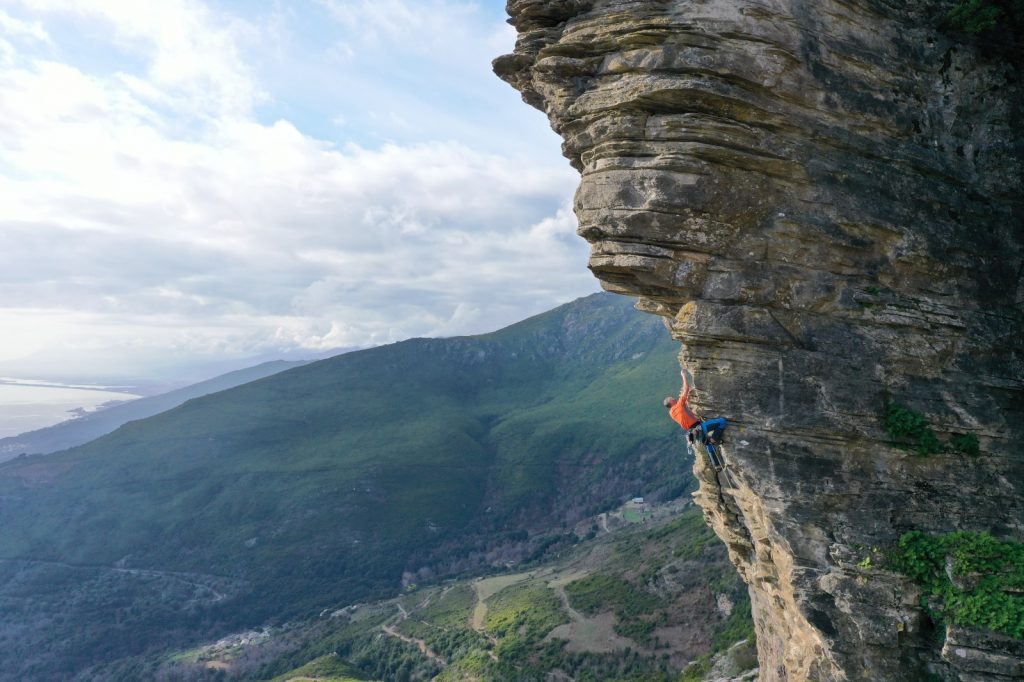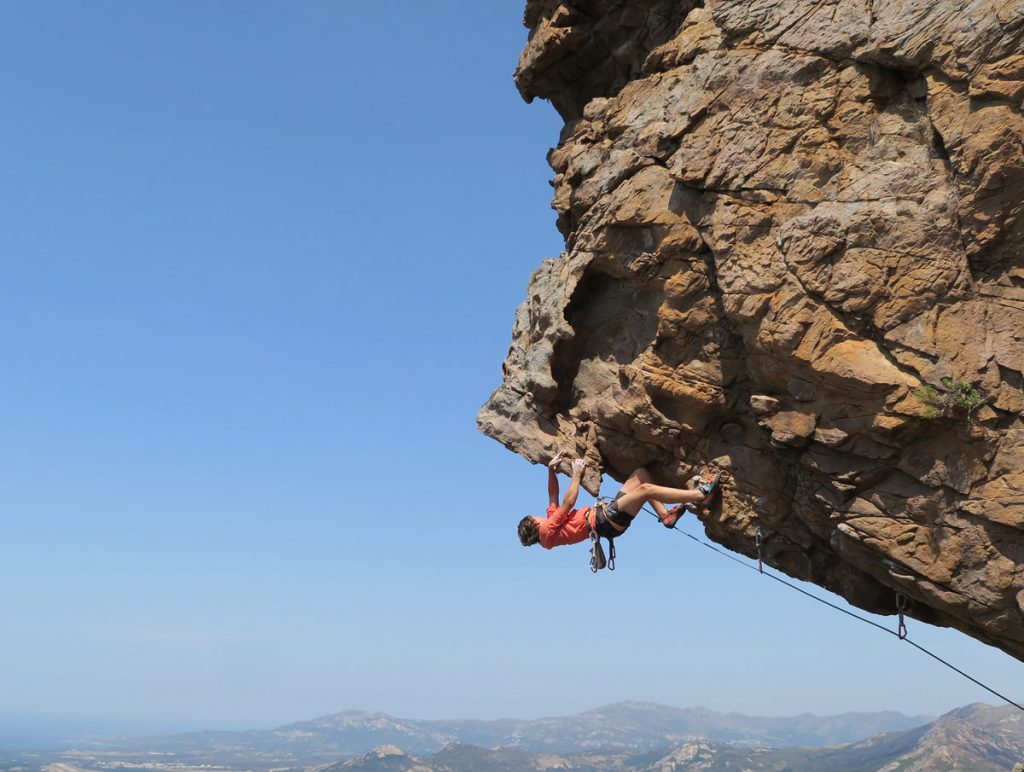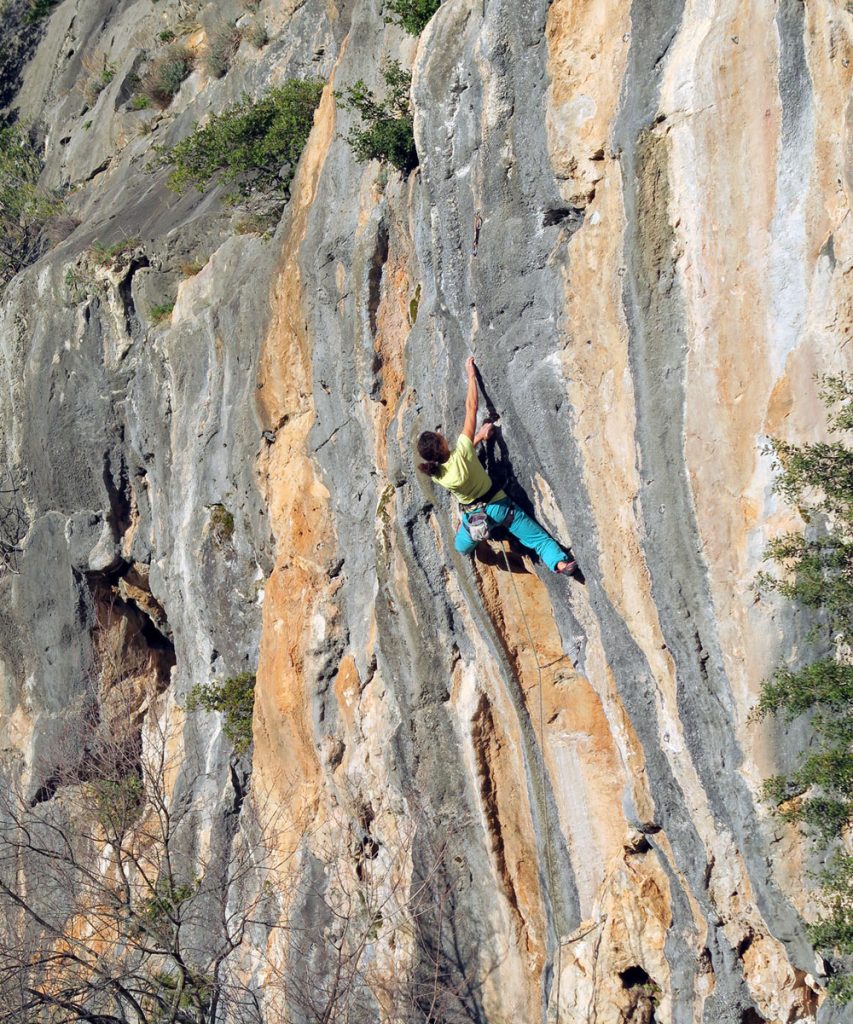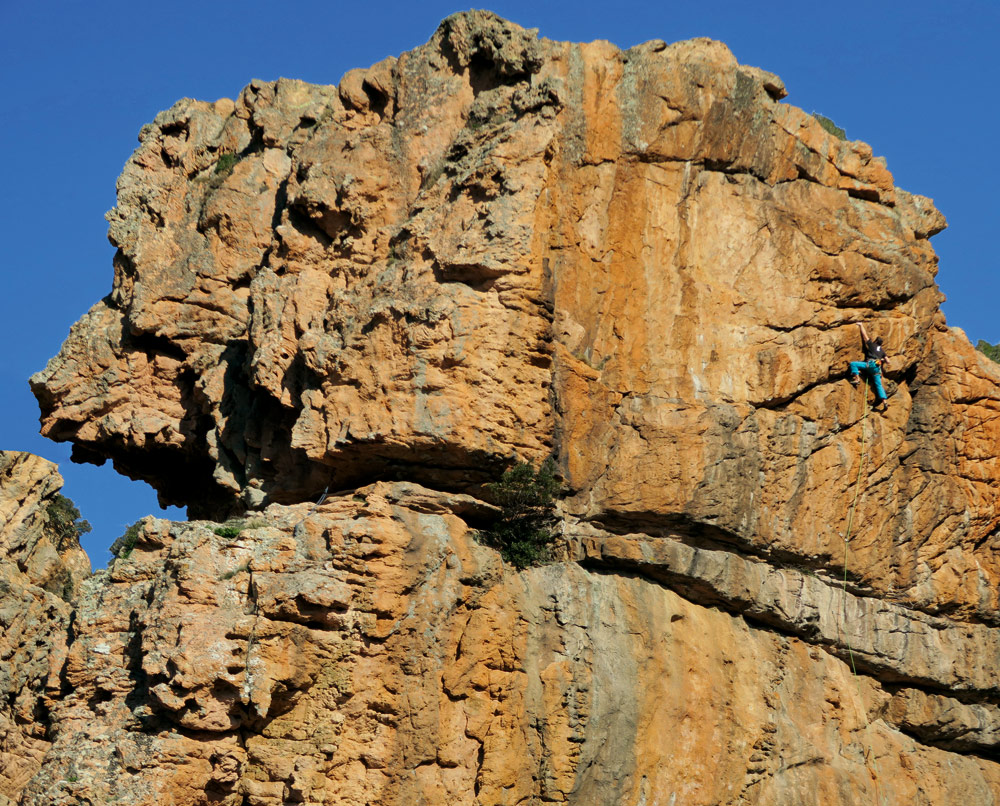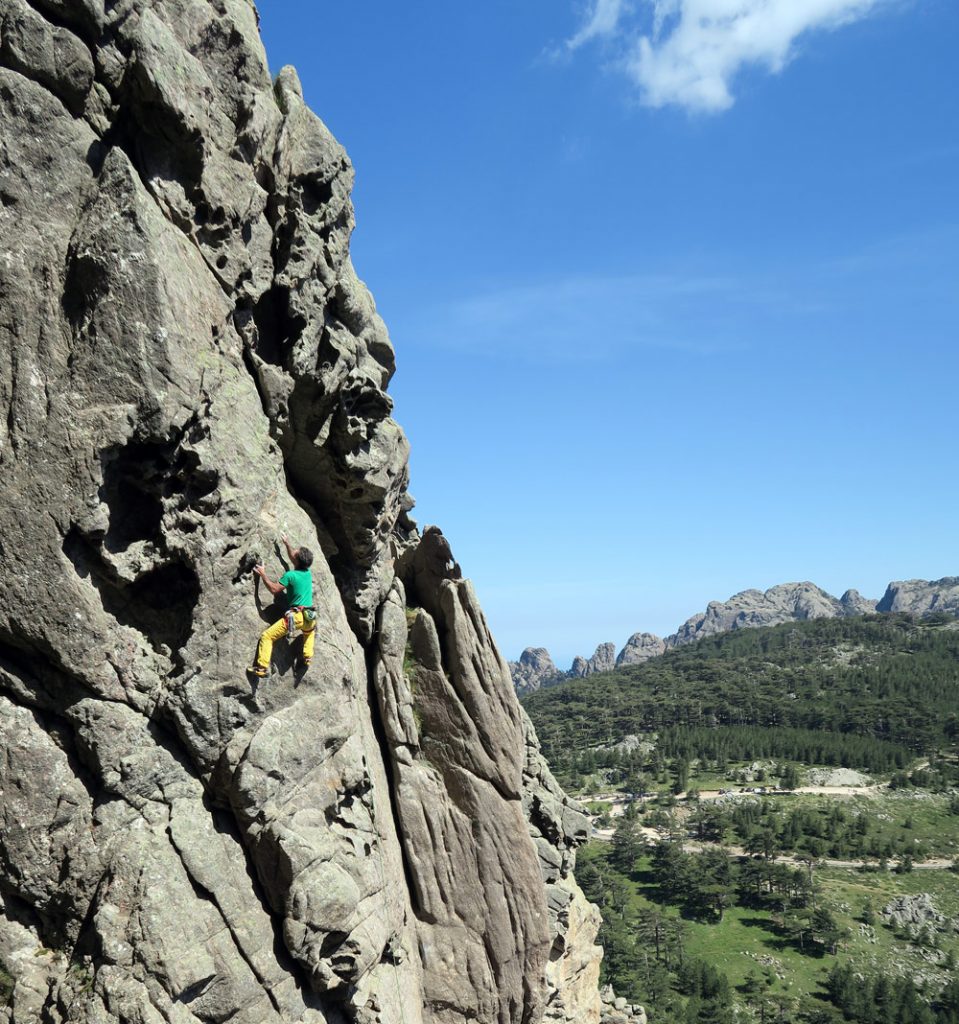Rock climbing in Corsica
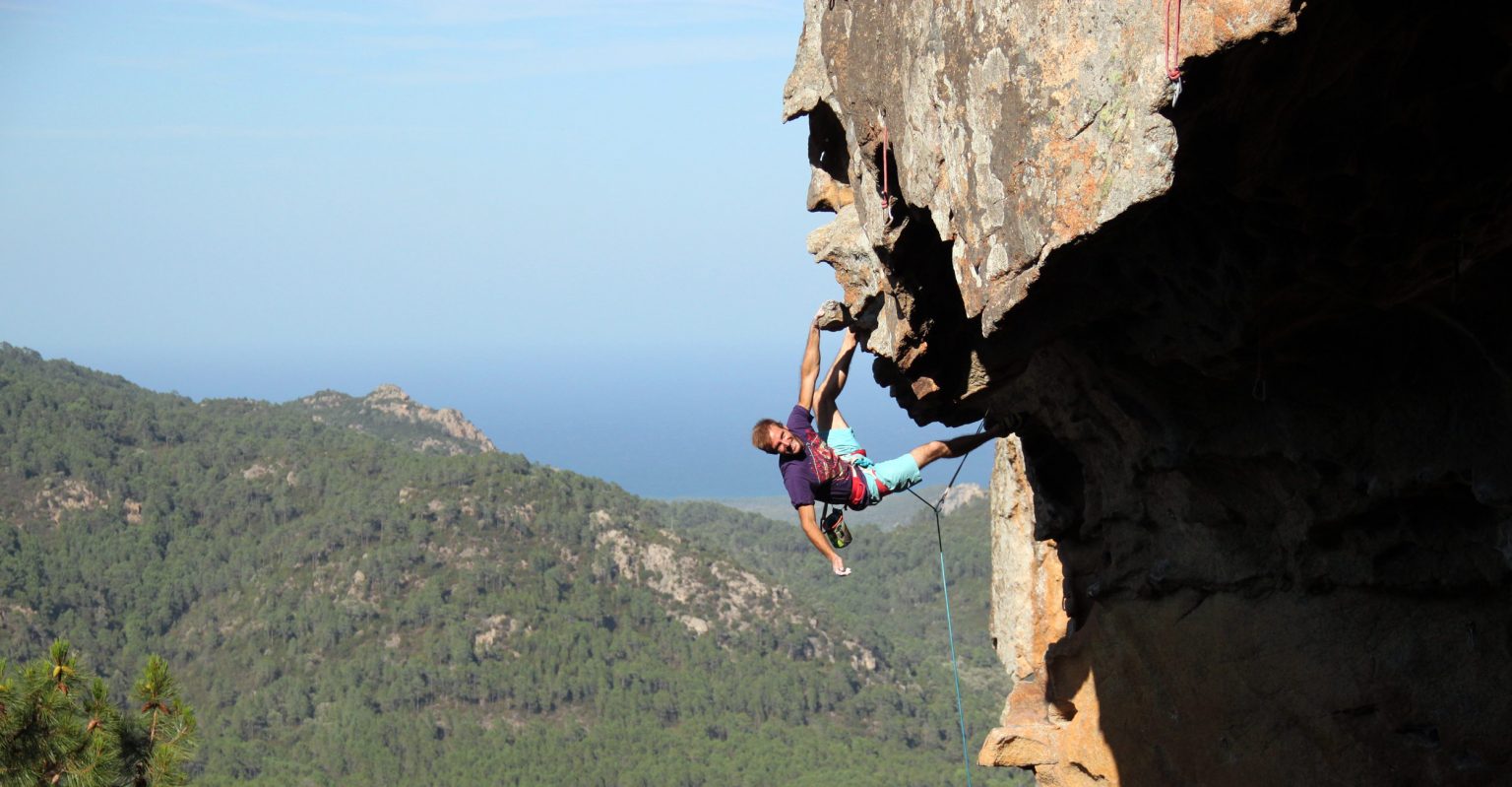
Sport climbing in Corsica
Here is a brief presentation of sport climbing from North to South in the main regions of Corsica. The average range of difficulty level is also indicated.
For each crags mentioned, links are provided to access additional information via the OmegaRoc webapp.
And when the temperatures rise and climbing in the sun feels more like torture than fun, it’s time to climb smart. For each region, we highlight summer crags as well as others that are still enjoyable – as long as you stick to the shaded times.
Almost all of the island’s crags are included in the guidebook Falaises de Corse.
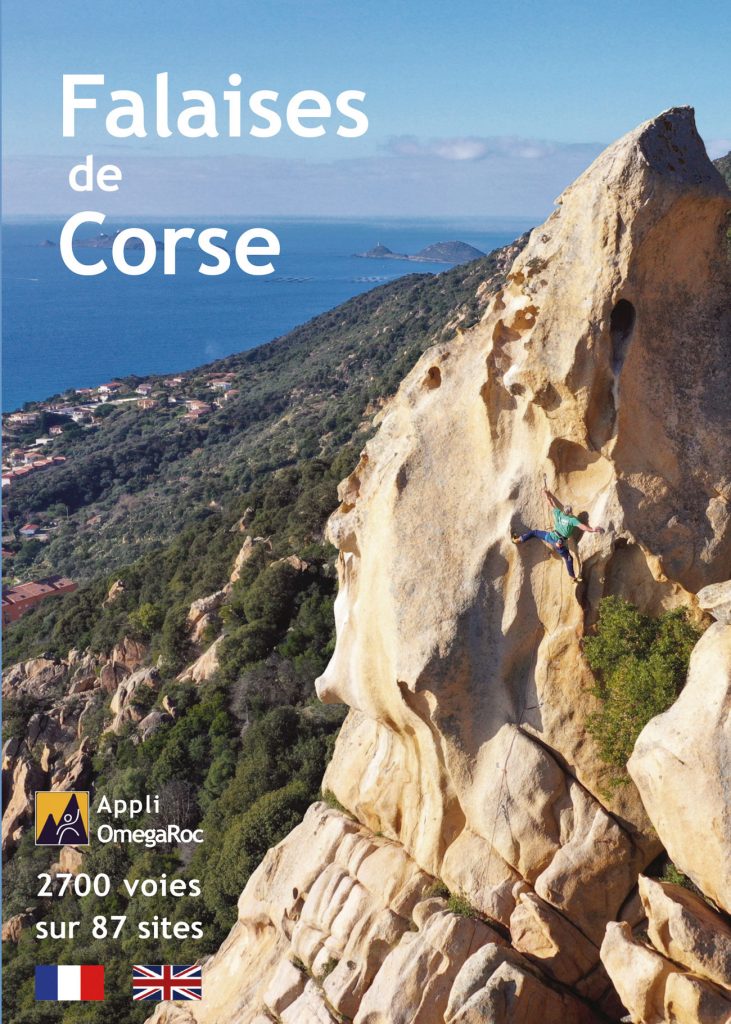
CRAG CLIMBING – BEST PRACTICES
Let’s climb smart and with consideration: respect the work of the route bolters, landowners, the natural environment… and fellow climbers.
Here are a few simple guidelines for more sustainable climbing.
The Bastia region.
The cliffs are mainly made up of shales or metamorphic limestone characterized by more or less pronounced layers. Often on overhanging walls, the climbing is physical and sustained on crimps and slopers. Although there are no very large climbing sites, but most are very interesting. The other regions of Alpine Corsica (Capicorsu, Castagniccia, Boziu..) are of no interest to climbers with the notable exception of Monte, the jewel of Castagniccia, one of the most beautiful crags on the island.
Note, in the region of San Fiurenzu (Saint Florent), local climbers have equipped many very overhanging sandy limestone crags. These crags are all located on private property and the landowners are not ‘’very enthusiastic’’. The rock is very fragile, and the bolts are quickly corroded.
Climbing in the summer:
The Bastia area has only one true summer crag: U Tipponu, which stays in the shade until 3 pm. The climbing is mostly technical on slabs. There’s no approach walk, but the crag is a bit too close to the road. Main grade range: 5c to 6b
Other crags worthwhile visiting:
E Torre: Shade from 11 am onward, short approach. Main grade range: 6a+ to 6b+
U Pignu – A Serra: Circular crag, you need to move with the sun. Main grade range: 5c to 6b
U Pignu – Face à la mer: Shade from 11 am, short approach. Main grade range: 6a+ to 6c
U Pignu – U Topu: Very small crag with a short approach, ideal for projecting a route. Grade range: 7a+ to 8a
Monte: Shade until 1 PM. Possibly the most beautiful crag in Corsica! Sustained climbing on gently overhanging rock. Main grade range: 7a to 8a+

La Balagne
La Balagne (Calvi – Isula-Rossa region) is better known for its beaches than for its crags. In recent years, climbing has developed well with the large and very beautiful crag of Suare .
In the magnificent setting of the Cirque de Bonifatu, a few single-pitch crags with routes right by the water are located just beside fully bolted multi-pitch routes of 4 to 5 pitches.
Additionally, a few smaller crags with various orientations and styles allow climbing all year round.
This region is suitable for climbers of all levels, except for the elite (above 8a).
Climbing in the summer:
The approach is a bit long, but the La Brèche sector in Suare stays in the shade all day and benefits from a constant breeze.
Main grade range: 5c to 6b
La Bibli goes into the shade around noon. The approach is quick, and the sea is just two meters away.
Main grade range: 5c to 6c
In Bonifatu, the La Vasque and JM Leroux sectors are in the shade from 1 pm, with your feet in the water.
Other crags worthwhile visiting:
Bonifatu – Le Bloc: Shade until 11 Quick approach and coolness from the river. 7 routes.
Main grade range: 5a to 6a and one 7b
Bonifatu – Melaghja Sector: Shade from 3 Routes range from 3 to 5 pitches + about ten single-pitch climbs. River nearby.
Main grade range: 5c to 6b
Suare (all sectors except La Brèche): Shade in the morning.
Main grade range: 6b to 7b


Central Corsica: The Golu Valley and the Upper Ascu valley
Although very rocky, the parallel Golu and Ascu valleys have relatively few bolted crags.
In the Golu Valley, the climbing areas are modest in scale. The Cuccia crag is the most significant, but it’s showing its age. Further downstream, in the gorges of the Scala di Santa Regina, new sectors are being developed (Funtana Vignente and Santa Laurina). These already offer the chance to enjoy one or two good days of climbing.
Suitable for climbers at level between grade 5a and 6b.
In the upper Ascu Valley, the rhyolitic cliffs of the Trimbulacciu cirque are more substantial. On this fine-grained rock, climbing mainly involves sloping holds of varying reliability and edges. Suitable for climbers at level between grade 5c and 7c.
Climbing in the summer:
The high-altitude cliffs of the Trimbulacciu cirque are an excellent climbing destination and are becoming increasingly popular.
Sous l’œil de Collina, facing north and surrounded by high peaks, gets no sun. The base of the routes is comfortable. This crag is suitable for climbers in the 6a to 7a range.
Illusions perdues is much more demanding and stays in the shade in the morning. In addition to the usual slopers and edges, there are also cracks.
Main grade range: 6b to 7c.
The Corti region – Francardu
The region of Corti (Corte) is undoubtedly the best developed. It is divided into two distinct areas : Francardu and The restonica Valley.
Around Francardu, many limestone crags are equipped. There are all climbing styles: wall with holes, vertical climbing on small holds, slabs, overhangs, and even a cave with some tufas.
Two major crags make up this area:
– Francardu, made up of around ten small sectors with varied profiles.
– Capuralinu is a long band of grey or white limestone. This steep cliff offers fairly physical climbing, often on small holds.
Suitable for climbers at level between 4c and 8a
Climbing in the summer:
In this region, a few crags provide nice days in the shade. However, altitude is no longer a factor here, so heatwave days can be unpleasant.
The Guy Cau sector, north-facing and situated in the forest, is divided into three small cliffs with very different styles. They offer around fifteen routes ranging from 6a to 7b.
Not too far away, with a fairly quick approach, La Barette sector allows climbing until about 3 pm. The routes are short but very demanding.
The beautiful and large Capuralinu cliff forms a wide arc, which the sun lights up gradually. While the lower Bulinu sector is only in the shade until 11 am, the upper sectors allow climbing until 3 or 4 pm.

The Corti region – The Restonica valley
– The valley of Restonica contains granite crags like beads on a string. There is something for all levels and all tastes. However, two styles stand out: the very sculpted walls for physical and exhilarating climbing (La Bigoudaine or Le Mur des abeilles at Sorbellu are good examples) and the red granite with round holds which require technique and endurance (Frassetta, Les Boules at Picellu).
Suitable for climbers at level between 4c and 8a
Climbingb in the summer:
Most of the cliffs in the valley face south and do not allow climbing in summer. Fortunately, there are a few well-shaded exceptions.
L’Oratoire is the most popular crag thanks to its easy access and many beautiful routes in the 5b to 6b range. The rock is fairly fractured but of excellent quality, and on-sight climbing here is a great challenge. In the Clocher sector, the routes are shorter but highly varied in style, with slabs, chimneys, cracks, and tafoni.
The nearby river is another bonus at this beautiful cliff.
Further up the valley, the perfect wall of A Tomba will delight climbers in the 6b to 7a range. There are only 9 routes, but what routes they are! Long, sustained endurance climbs on perfect vertical granite.
Even further up the valley, near the Grotelle sheepfolds, Chez Téo offers around ten routes, mostly in the 6b to 6c range. The climbing is superb, but since the road below has been closed, the approach is long, very long (2 hours). Chez Téo is suitable for climbers from 4c to 8a.
The Portu region :
Well equipped with high-level multi-pitch routes, this region has long been forgotten in terms of sport climbing. The complete rebolting of the Portu beach crag and the bolting of the very beautiful La Lonca had changed this situation.
Unfortunately, following a major rockfall, the latter is closed until further notice.
Note, inland, the Ortu site, offered both bolted single- and multi-pitch routes. This site is currently closed by the municipality because of the FFME disengagement in all climbing crags at the national level. A recent change in the law provides hope that the ban will soon be lifted.
Climbing in the summer:
Right by the sea and in the shade almost all day, the Portu crag is very popular. It only gets sun in the mid-afternoon, right when you’re tired and it’s time for a swim. The routes are fairly short but very interesting. The climbing is technical and sometimes a bit physical.
Main grade range: 4a to 6b.

The Aiacciu region
In the Aiacciu (Ajaccio) region, three important sites stand out:
– Le Gozzi is a mix of sport crags and multi-pitch routes. After a tiring approach, the reward is worth it: superb long and airy routes, and a four-star view.
– At the entrance of the city, the site of Saint Antoine consists of multiple sectors with a dominant friction slab and cracks. There are also some overhanging profiles.
– Inland, near the village of Bucugnà, la Richjusa has many sectors of varying levels. In summer, only la Source and Le Chameau sectors are passible.
This region also has several smaller crags.
Suitable for climbers at level between 4b and 8a
Climbing in the summer:
At Richjusa, the La Source sector is well-suited for summer climbing. Although it gets sun fairly early, the base of the cliff remains well shaded, and a thermal breeze usually picks up by late morning. This beautiful crag offers two distinct climbing styles:
On the left, the grippy grey granite provides a technical, sensation-based climbing.
On the right, the rock is red, steeper, and more sculpted, providing a more conventional and physical experience.
With routes ranging from 20 to 25 meters, climbers in the 5c to 6b range will be delighted.
At Gozzi, several sectors are climbable in the height of summer, provided you’re willing to tackle a long, steep approach through the maquis. There’s only one solution: start very early (6 am). But you won’t regret it, once you’re there, there’s plenty to climb, from 5c to 7b, and it’s all excellent.
Dos au Mur sector is a deep, dark gorge. The routes here are always in the shade and climb a steep, technical 50-meter wall.
Saga Corsica sector consists of an east face and a north face, which are completely different in style.
-On the east face, the steep overhang offers classic Gozzi climbing on sloping, sculpted features.
– On the north face, the vertical profile provides varied, but always technical, climbing.

The Taravu valley
This large valley in the inland has many cliffs, but very few have been developed for climbing. The crag of Petra Piomba near the village of Livesi (Olivese) is the most interesting, especially in the high level or even the very high level. Well protected by a large roof, this cliff is passable also on rainy days.
At the entrance of Alta Rocca, l’aiguille de la Tana offers, in addition to the single-pitch crag, small multi-pitch routes perfect for initiation.
Climbing in the summer:
Facing east, the La Tana single-pitch sector goes into the shade around noon. On very abrasive and sculpted rock, a good fifteen routes have been bolted, mostly in the 5c to 6a+ range. But be careful, the placement of the belays often makes top-roping impossible.
In the morning, you can climb the short multi-pitch routes on the west face. There’s no need to reach the summit, the first pitches are beautiful, on highly sculpted rock.
Main grade range: 5c to 6a.
Bavella and the southern region
In the Southern region, the climbing sites are concentrated in the Bavella massif and on the eastern coast; nothing on the western side.
The col de Bavella is a paradise for climbers evolving between 4b and 7b. High level climbers will enjoy the crags further down the Sulinzara route. Note, at the Col de Bavella, the superb trad crag of Punta Bigornu. In the shade all day, it is suitable for climbers progressing between 6a+ and 7b on trad.
Several sport crags are scattered on the road between the Col de Bavella and Sulinzara. The main ones are :
La Baraka : Very few routes, but this is where you will find the superb eponymous crack in 8a on trad.
Mescaline : A crag well protected from sun and rain. The routes are short and rather bouldery. Level: between 7b and 8b
Le 3G/3G+ : Two very beautiful sectors and many routes in the 8th. Level: between 6c and 8b
Le Barring : This is the reference high level crag of the South. Level: between 7a and 8c
Finally, there are some beautiful crags between Sulinzara and Purtivechju (Porto Vecchio) :
Les 3 Caves which allows you to climb all year round, offers a variety of profiles. Superb climbing between 6a and 8a.
A Tyroliana, smaller, but facing north is also a good solution in summer. Level 6c-7b
The limestone crag of Punta Calcina is also very interesting in various styles.
Climbing in the summer:
The Bavella Pass climbing area consists of about a dozen sectors. While many are south-facing and require waiting until mid-afternoon to climb comfortably, it’s possible to combine the other ones smartly for a five-star climbing day.
In the morning, the Campanella sector is in the shade. The climbing is fairly physical on highly sculpted rock, with grades ranging from 5c to 7a.
Around 2 pm, you can head over to the Murzella cliff, just a 5-minute walk away. Here, the climbing is more technical, with a strong concentration of routes in the 5c to 6b range.
For something different, about a 30-minute walk from the pass, the Punta Bigornu is a true summer crag. This canyon, formed by two steep walls, always has at least one face in the shade, and you can usually count on a light breeze.
Note: Punta Bigornu is a trad cliff (only the belays are bolted), with a few bolts placed where natural protection is impossible.
Heading down toward the east coast, the 3G site is a flagship cliff in the region. The routes are long and magnificent, both physical and technical. The approach, however, is less enjoyable: a steep 20-minute hike through the forest. To really enjoy climbing at 3G, you should be comfortable climbing at least 6c. After that, it’s open bar up to 8b.
If 3G isn’t your scene, there’s the brand-new Malaspina site (2023–24), starting from Ponte Grossu. The beginner-friendly Initiation sector (3a to 5c) is shaded in the morning. A little further on, the Jerba sector stays in the shade much longer. Main grade range: 5a to 6a+
Further south, heading toward Portivechju (Porto-Vecchio), Les 3 Caves is one of the most beautiful cliffs in the area. It’s not strictly a summer crag, since its proximity to the sea makes it climbable year-round. The main face, northeast-facing, only gets sun early in the morning. On this steep wall, climbing is mostly technical. To the left, the Faut Pacifier sector goes into the shade in the early afternoon. The climbing here is much more physical, on beautiful overhanging red granite.
The only downside is the longer approach due to the closure of the access track and parking restrictions.
A bit further up the valley, A Tyroliana is a beautiful vertical to gently overhanging wall that stays shaded all day.
The rock is highly sculpted, full of rounded holds, and the many boulder-style cruxes are especially satisfying to figure out.
From 6a to 8a+, all levels are represented, with a high density of sustained and demanding routes in the 6c to 7b+ range.

